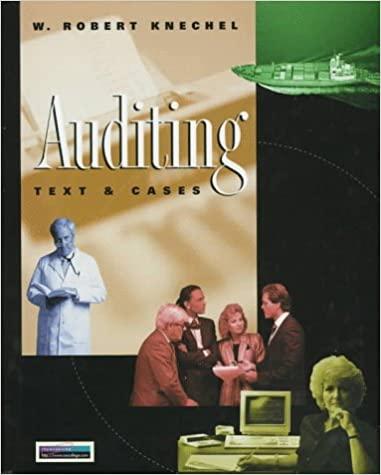Question
Estimated Income Statements, using Absorption and Variable Costing Prior to the first month of operations ending October 31, Marshall Inc. estimated the following operating results:
Estimated Income Statements, using Absorption and Variable Costing
Prior to the first month of operations ending October 31, Marshall Inc. estimated the following operating results:
| Sales (27,200 x $96) | $2,611,200 | ||
| Manufacturing costs (27,200 units): | |||
| Direct materials | 1,572,160 | ||
| Direct labor | 372,640 | ||
| Variable factory overhead | 174,080 | ||
| Fixed factory overhead | 206,720 | ||
| Fixed selling and administrative expenses | 56,200 | ||
| Variable selling and administrative expenses | 68,000 | ||
The company is evaluating a proposal to manufacture 30,400 units instead of 27,200 units, thus creating an ending inventory of 3,200 units. Manufacturing the additional units will not change sales, unit variable factory overhead costs, total fixed factory overhead cost, or total selling and administrative expenses.
Question Content Area
a. 1. Prepare an estimated income statement, comparing operating results if 27,200 and 30,400 units are manufactured in the absorption costing format. If an amount box does not require an entry leave it blank.
| 27,200 Units Manufactured | 30,400 Units Manufactured | |
| Contribution marginFixed manufacturing costsInventory, October 31SalesSelling and administrative expensesSales | $Sales | $Sales |
| Cost of goods sold: | ||
| Cost of goods manufacturedCost of goods soldFixed manufacturing costsInventory, October 31SalesCost of goods manufactured | $Cost of goods manufactured | $Cost of goods manufactured |
| Contribution marginCost of goods manufacturedFixed manufacturing costsInventory, October 31Selling and administrative expensesInventory, October 31 | Inventory, October 31 | Inventory, October 31 |
| SalesSelling and administrative expensesTotal cost of goods manufacturedTotal cost of goods soldTotal fixed manufacturing costsTotal cost of goods sold | $Total cost of goods sold | $Total cost of goods sold |
| Fixed manufacturing costsFixed selling and administrative expensesGross profitInventory, October 31SalesGross profit | $Gross profit | $Gross profit |
| Contribution marginCost of goods soldInventory, October 31SalesSelling and administrative expensesSelling and administrative expenses | Selling and administrative expenses | Selling and administrative expenses |
| Operating incomeOperating lossOperating income | $Operating income | $Operating income |
Feedback Area
Feedback
a. 1. Recall that under absorption costing, the cost of goods manufactured includes direct materials, direct labor, and factory overhead costs. Both fixed and variable factory costs are included as part of factory overhead. Calculate unit cost for direct materials, direct labor, variable factory overhead, fixed factory overhead. Add together to get total unit cost. For 30,400 units, use the same unit costs for direct materials, direct labor, and variable overhead, but instead recalculate the fixed factory overhead and add this to obtain the unit cost at the 30,400 unit level. Sales - (cost of goods manufactured - Inventory, October 31) = Gross profit; gross profit - selling and administrative expenses = income from operations. Remember that the Inventory, October 31 adjustment will only be necessary at the 30,400 level.
Question Content Area
a. 2. Prepare an estimated income statement, comparing operating results if 27,200 and 30,400 units are manufactured in the variable costing format. If an amount box does not require an entry leave it blank.
| 27,200 Units Manufactured | 30,400 Units Manufactured | |
| Contribution marginFixed factory overheadSalesVariable cost of goods manufacturedVariable cost of goods soldSales | $Sales | $Sales |
| Variable cost of goods sold: | ||
| InventorySalesVariable cost of goods manufacturedVariable cost of goods soldVariable selling and administrative expensesVariable cost of goods manufactured | $Variable cost of goods manufactured | $Variable cost of goods manufactured |
| Contribution marginFixed factory overheadInventory, October 31Manufacturing marginSalesInventory, October 31 | Inventory, October 31 | Inventory, October 31 |
| Contribution marginInventoryTotal variable cost of goods manufacturedTotal variable cost of goods soldTotal variable selling and administrative expensesTotal variable cost of goods sold | $Total variable cost of goods sold | $Total variable cost of goods sold |
| Contribution marginFixed factory overheadManufacturing marginSalesVariable cost of goods manufacturedManufacturing margin | $Manufacturing margin | $Manufacturing margin |
| Contribution marginFixed factory overheadManufacturing marginVariable cost of goods soldVariable selling and administrative expensesVariable selling and administrative expenses | Variable selling and administrative expenses | Variable selling and administrative expenses |
| Contribution marginFixed factory overheadManufacturing marginSalesVariable cost of goods manufacturedContribution margin | $Contribution margin | $Contribution margin |
| Fixed costs: | ||
| Fixed factory overheadFixed inventoryFixed manufacturing marginFixed salesVariable selling and administrative expensesFixed factory overhead | $Fixed factory overhead | $Fixed factory overhead |
| Fixed contribution marginFixed selling and administrative expensesFixed inventoryVariable cost of goods soldVariable selling and administrative expensesFixed selling and administrative expenses | Fixed selling and administrative expenses | Fixed selling and administrative expenses |
| Total fixed costs | $fill in the blank 4b42bbf9ffc3f9e_28 | $fill in the blank 4b42bbf9ffc3f9e_29 |
| Operating incomeOperating lossOperating income | $Operating income | $Operating income |
Question Content Area
b. What is the reason for the difference in operating income reported for the two levels of production by the absorption costing income statement?
The increase in income from operations under absorption costing is caused by the allocation of
fixed factoryvariablefixed factory
overhead cost over a
fewerlargerlarger
number of units. Thus, the cost of goods sold is
lessmoreless
. The difference can also be explained by the amount of
fixed factoryvariablefixed factory
overhead cost included in the
beginningendingending
inventory.
Step by Step Solution
There are 3 Steps involved in it
Step: 1

Get Instant Access to Expert-Tailored Solutions
See step-by-step solutions with expert insights and AI powered tools for academic success
Step: 2

Step: 3

Ace Your Homework with AI
Get the answers you need in no time with our AI-driven, step-by-step assistance
Get Started


